I headed to my first race of 2017, the January 21 Coastal Trail Runs’ Crystal Springs 50K, with low expectations and depressed feelings. Count me among Americans who listened to the presidential inauguration the prior day with dismay. A big part of me said to spend Saturday devoted to the Women’s March. But we all cope with situations in different ways, and I craved peace and camaraderie, not big crowds, in the ferny redwoods of Huddart Park in Woodside. Plus, my long-range training schedule called for a solid extra-long run this weekend.
This early-season race would be a good, challenging training run, I told myself. “This will be a supported long run to kick my butt, period,” I messaged my friend Penny Macphail, encouraging her to join me. “I’m not going to really race until later in the season.”
“Perfect. … I think I need the fun of being at a race,” she wrote back, echoing my sentiments.
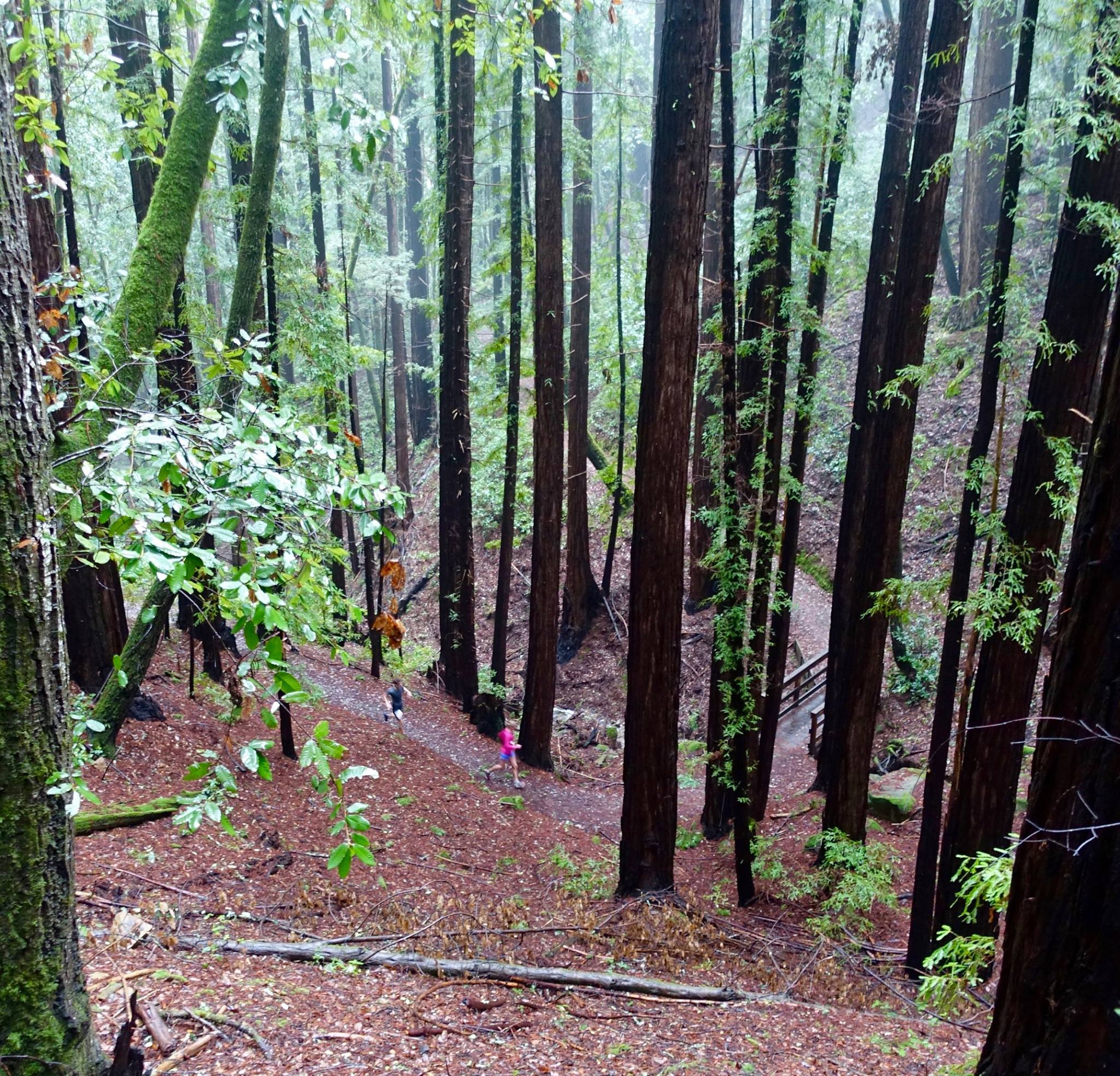
I love this photo by Scott Dunlap of runners through Huddart Park in the Crystal Springs 50K. It captures the magnificence of the trees and the gentleness of much of the trail.
Trail runners often characterize their races as “just a training run,” sometimes as an excuse to sandbag, or sometimes as a coping mechanism to handle anxiety over the prospect of giving maximum effort for best results. If, for whatever reason, you decide not “to really race” to your athletic potential, then how can you deliberately use the race for training and get the most out of it to benefit your season?
I decided to use this post to share advice on how to use a race as an effective training run to help fulfill a longer-term race goal. (A couple of gear recommendations and misc. notes also follow.)
An “all-out assault” vs. “mediocre social gathering”?
Some coaches feel strongly that you should toe the line if and only if you are prepared to race competitively, giving your best effort. Five years ago, I approached a notable coach about potentially working together, and he sent me a summary of his training philosophy, which included this about racing: “Race seldom, and keep the races quality! If you step to the line, step to the line to race. The purpose of a race is to get from the starting line to the finish line as quickly as you can. If you carefully select your races, then they will be higher quality performances than if you try to do it too often. … Make them all-out assaults instead of mediocre social gatherings.”
While I understand and respect his point—and recognize it’s one reason he has elite-level competitors as his clients—I use a different approach for my clients and my own training.
The A, B, C’s of choosing races
Instead of the all-or-nothing characterization of races as either “all-out” or “social gatherings,” I categorize races three ways:
1. An “A” Race: This is your top-tier goal, the culminating event of your training season. This is the race you feel most passionate about and that you tailor your training toward. For this race, you do everything in your power to perform your best. You devote your peak training weeks to preparing specifically for this event’s terrain, elevation profile and climate. You thoroughly do your homework about the course to mentally and logistically prepare. You taper just right in the two weeks leading up to race day. You start the race with a finely tuned plan about how to pace the miles, and a commitment to do the best you’re capable of on that day. You put your heart into it.
Last year, my “A” race was the Western States 100-mile Endurance Run. This season, it’s the Mauna to Mauna Ultra self-supported stage race in May. In the fall, it’ll be the Javelina Jundred, where I hope to set a 100-mile PR. (There, I went public with that goal, no turning back now!)
2. A “B” Race: This is a race that serves the purpose of practicing and conditioning for the “A” race. Often the “B” race is shorter than the “A” race, functioning as a stepping stone to the longer distance. You “really race” it and go “all out,” to become better at racing; that is, you endeavor to run as fast, smart and efficiently as possible. But, it is not your season’s main event; rather, it’s a dress rehearsal. You test out strategies and gear, and possibly make mistakes from which you learn. You let the “B” race interrupt your regular training routine because you taper your volume during the seven to ten days leading up to it, and you give yourself several days to a full week to recover from it; then, you return to focused, peak-level training for the “A” race.
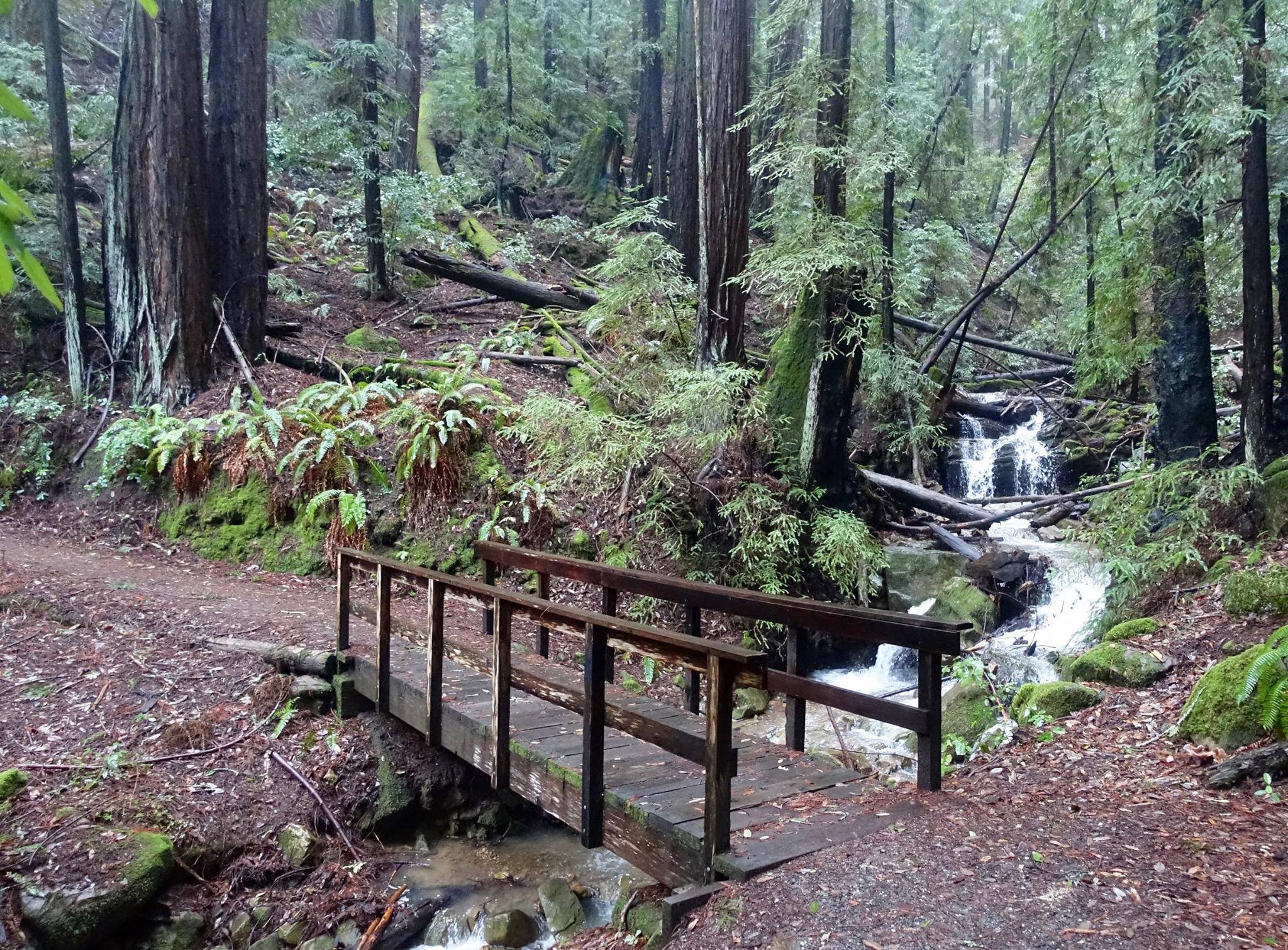
A “B” race is a bridge to the goal of an “A” race. Photo of the Crystal Springs 50K course by Scott Dunlap
Last year, the Lake Sonoma 50 was my main “B” race leading up to Western States (and the Marin Ultra Challenge 50K was a “B” race in preparation for Lake Sonoma). This season, I’ll treat the Salmon Falls 50K in late February as a “B” race. If I get into the 100-mile Wasatch Front Endurance Run in early September (lottery to be held February 4), I’ll have to decide whether to approach it as a “B” or “A” race. One could argue that any 100-miler demands an “A”-level effort. But I’m inclined to make Javelina the “A” goal for that season and Wasatch a big “B” leading up to it.
3. A “C” Race: This is the race you call “just a training run.” You train normally the week prior, rather than tapering your volume and intensity, and you put little if any special preparation into it.
You might be asking, why spend a hefty registration fee to participate in a race rather than going on a long run solo or with a few friends? Good question. Most if not all of the time, a regular long run is all you need. But if, on occasion, you lack the motivation to go the distance of a scheduled long run; or if you want to explore a new trail route, or a new region, and want the support of course marking ribbons and aid stations, then participating in a race is a smart and fun way to have a great long run.
Chances are, you will run with higher effort and sharper focus in the context of a race than you would on your own, even if you are giving less than your “all-out” best, so the “C” race is likely to be a higher-quality workout than a solo long run.
Here are five “C” words to further define a “C” race and help you run it deliberately for training purposes:
- Calm: In a “C” race, when you release the pressure to place or perform at your maximum level, then you can practice and enjoy a calm, steady, relaxed state of running. This mode of calm running is essential for the early miles in ultras, when going out too fast or stressed will sabotage your race.
- Cautious: A “C” race isn’t worth hurting yourself for. Be a little less gutsy and a little more careful over challenging terrain. If you feel an old injury start “talking to you,” then dial back your pace or take a break to address the problem, rather than trying to run through it.
- Casual: Your approach to a “C” race should feel laid back; and ideally, the event itself is more casual than uber-competitive. You are out there mainly to have fun and enjoy the day, not to beat a prior time or beat others.
- Constructive: A “C” race builds you up; it doesn’t damage or overly deplete you. Sure, you’ll feel fatigued the next couple of days, but you should feel the “good” kind of fatigue that signals you stressed your body in a positive way that leads to adaptation and progress. You should be able to return to normal training after only one or two recovery days.
- Camaraderie: You should always be nice and use good trail-racing etiquette in each and every race. But in a “C” race, when performance matters less, it’s definitely incumbent on you to act as a trail steward and good ambassador. Talk to other runners if they feel like talking; chat with aid station volunteers and always thank them. Do your best to boost the spirits of other participants and help anyone who needs it. Go to the trouble to pick up trash if you spot it on the trail; don’t race by thinking, “The sweepers will get that.” No mere “mediocre social gathering,” this a time to form friendships and have fun!
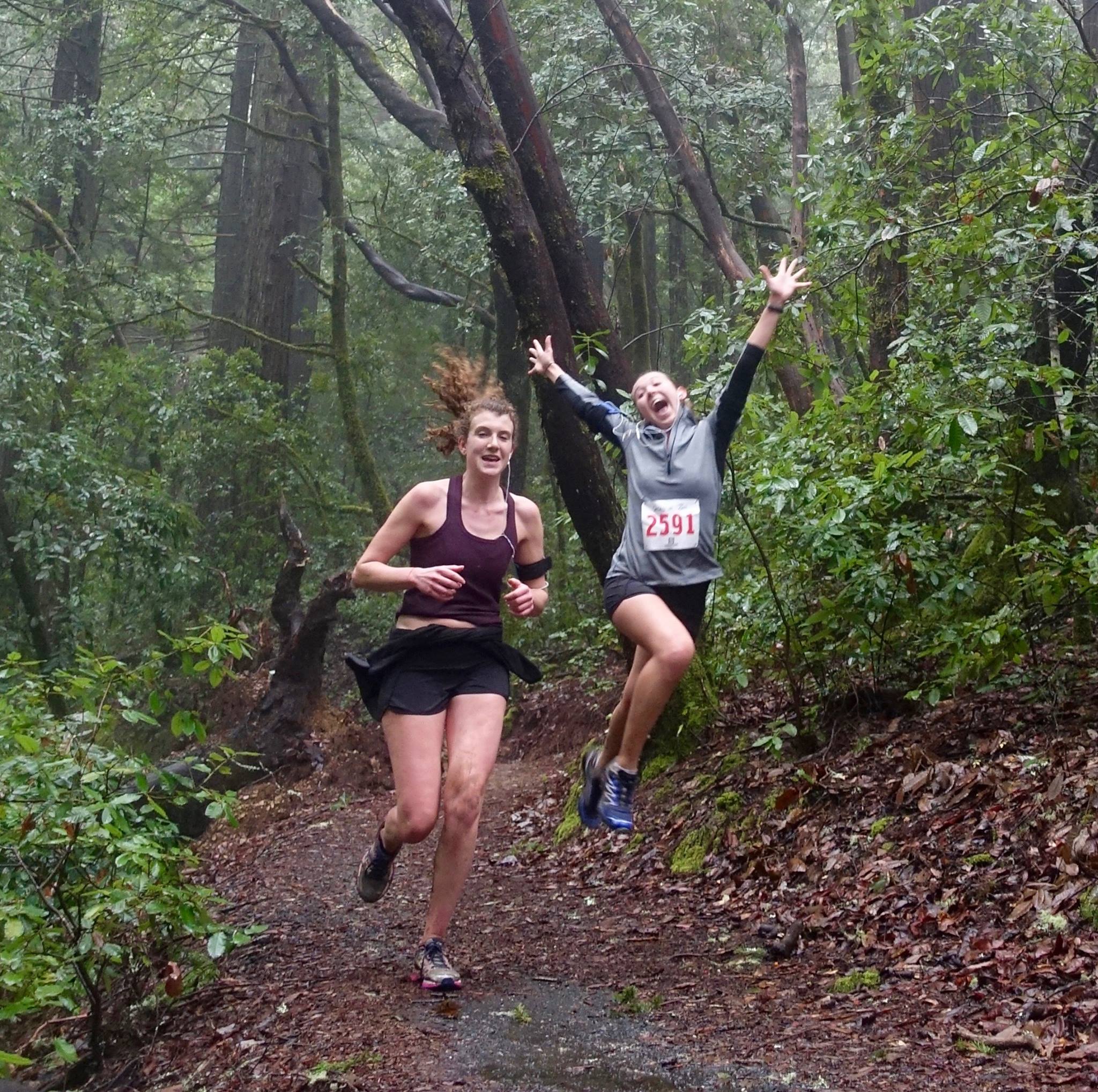
I don’t know who these women are. I just admire their joy. Thanks to Scott Dunlap for taking this and other photos during the race; please see link at the end to his blog.
My race unfolded as I hoped. I started steady and strong but stress-free; I spent about an hour caught up in conversation with another guy who was running my pace, until he sped up and I let him go; I reveled in the damp forest and admired the roaring runoff, the result of so much precipitation this month—enough to end the drought in Northern California! I chug-chug-chugged up the uphills, cautiously and slowly picking my way over several downed trees.
The final portion of the route follows smooth, rolling singletrack for about 6 miles, then a steady descent of some 1000 feet over the last 4 miles. The spongy, runnable forest path enticed me to speed up and practice faster downhill running. Tired and eager to be done, I pushed faster as if blowing off steam, channeling and processing a lot of pent-up emotion and stress. But I never crossed over to significant discomfort.
This 50K, “just a training run” or what I’d call a “C” race, proved to be a beautiful, focused, steady long run that provided escapism and support—and, a better-quality workout than I probably could have or would have accomplished on my own.
Big congratulations to Penny, who ran hard to break 5 hours and finished 1st female, 5th overall (full results here). And she did it with a rubber chicken strapped to her hydration pack. When Penny turned 49 earlier this month, she vowed to carry a rubber chicken with her for the entire year, as part of a campaign to raise money for Oxfam to buy real chickens to fight hunger. She’s that kind of person!
Please check out her fundraising site and join me in making a donation.
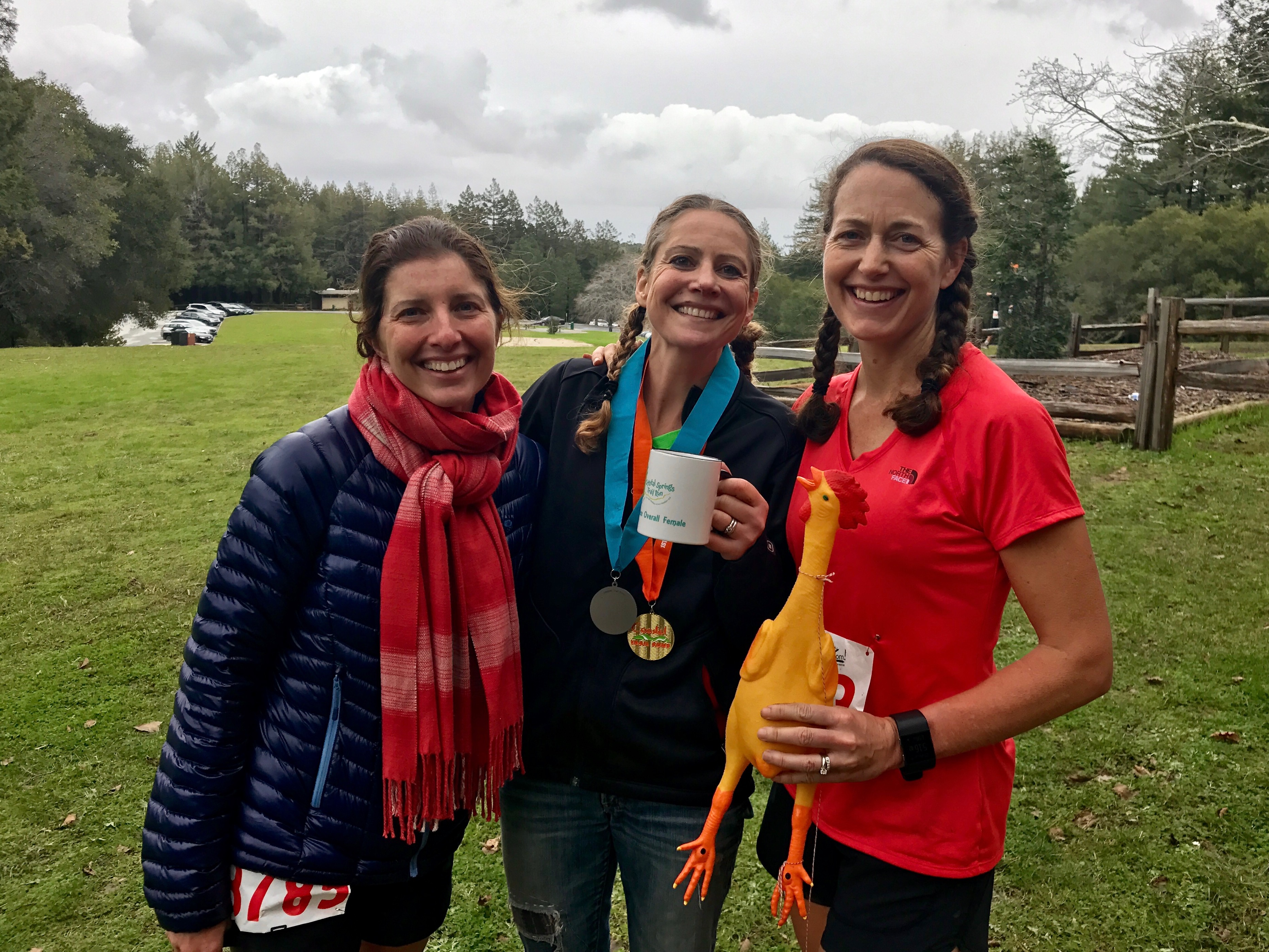
At the finish line, I hung out with my friends Heather Sutherland and Penny Macphail. Penny let me hold her chicken. Please donate to her campaign (link in text above) to buy real chickens to fight hunger!
Clothing & shoe recommendations
At the race, I wore a new pair of shorts from the company rabbit. I heard about this company in December, through one of their sponsored ultrarunners, Sabrina Little, and through this well-done review by Jade Belzberg on UltraRunnerPodcast. I bought the size s hopper shorts (the company has a thing about lowercase letters). My go-to shorts for years have been the North Face “Better Than Naked” shorts. I like these just as well and perhaps better, though I’m still getting used to them. In particular, I like how they sit low on the hips, just snug enough to stay up but with zero tightness around the abdomen. They feel like “barely there” shorts—no drawstring, smooth and unnoticeable seams, soft fabric. Thumbs up!
I also broke in the new model of Hoka Challengers, the ATR 3. They felt really good … but honestly, not significantly different from the ATR 2’s. This is why I don’t write shoe reviews; I can’t discern the subtle differences from one year’s model to the next, nor do I care. They either feel good and work well on my feet, or they don’t. I loved my Challenger ATR 2’s except that they prematurely (like, after just a couple hundred miles) developed holes in the fabric sides. Let’s hope these are more durable. Thumbs up (for now)! Read the iRunFar Hoka Challenger ATR 3 review for details on this shoe.
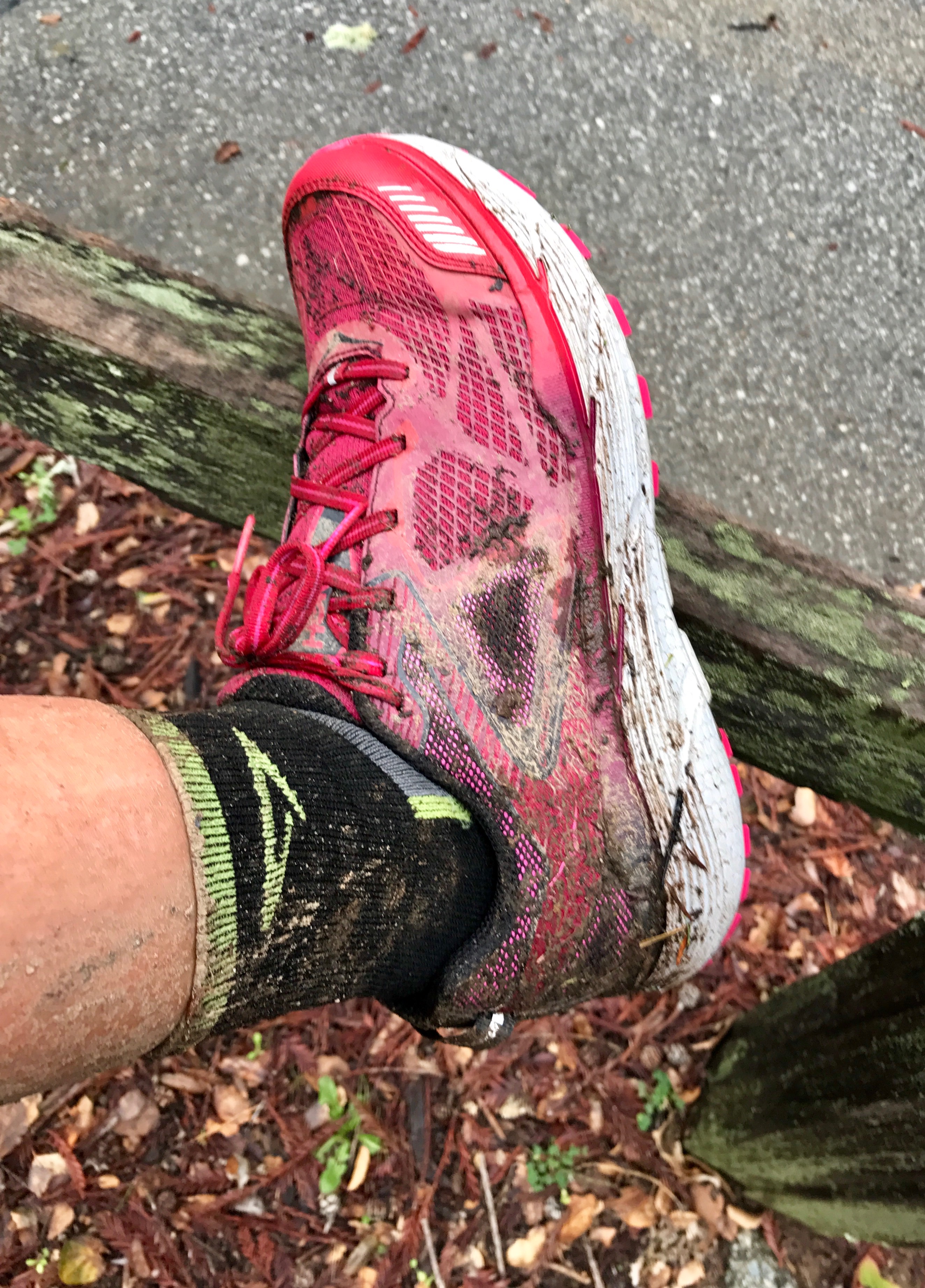
My new Hoka Challenger ATR 3’s. Huge thanks to Oakland’s Transports store, especially owner Richie Boulet, for getting me an early release of these.
Last but not least … some personal news
I received exciting news last week that I was named the overall winner in the UK-based RunUltra‘s best blogger contest—an international contest with a shortlist of 62 nominees! I sincerely thank all my readers and friends who clicked through to vote for me and who sent me encouraging messages about this blog, The Runners Trip. I will write a guest blog post for RunUltra sometime soon. Here’s the news story about the contest winners.
This year is off to a good start for me personally and running-wise. I made it past Week 3 of my commitment to abstain from alcohol in January, to achieve better moderation the rest of the year (which I’ll explain in a later blog post). That’s actually a very big deal for me; I didn’t think I could do that—didn’t think I could go even a full week—unless I were pregnant and had to.
My book manuscript made it through copyediting and is heading into production soon, to be released by Globe Pequot Press in late April or early May. (I’ll blog a lot more about that later! Suffice now to share the title: The Trail Runner’s Companion: A Step-by-Step Guide to Trail Running and Racing, from 5Ks to Ultras.) I need to get over the hump this week of finishing an article for Trail Runner, and preparing for and presenting at a meeting in Ojai for the board I serve on (for Thacher School). Finally, in early February, I’ll get a chance to return to Sacramento and record a couple of UltraRunnerPodcast shows with Eric.
That’s another reason I ran the Crystal Springs 50K: I knew the upcoming week would be “a cutback week” when travel and work prevent much running. Last year, my mileage hit 2500, and my goal this year and for the years to come is to maintain that level. That means an average of 50 miles/week, assuming I take a week off completely after Mauna to Mauna and Javelina.
As one of my favorite mid-ultra mantras goes, “So far, so good.”
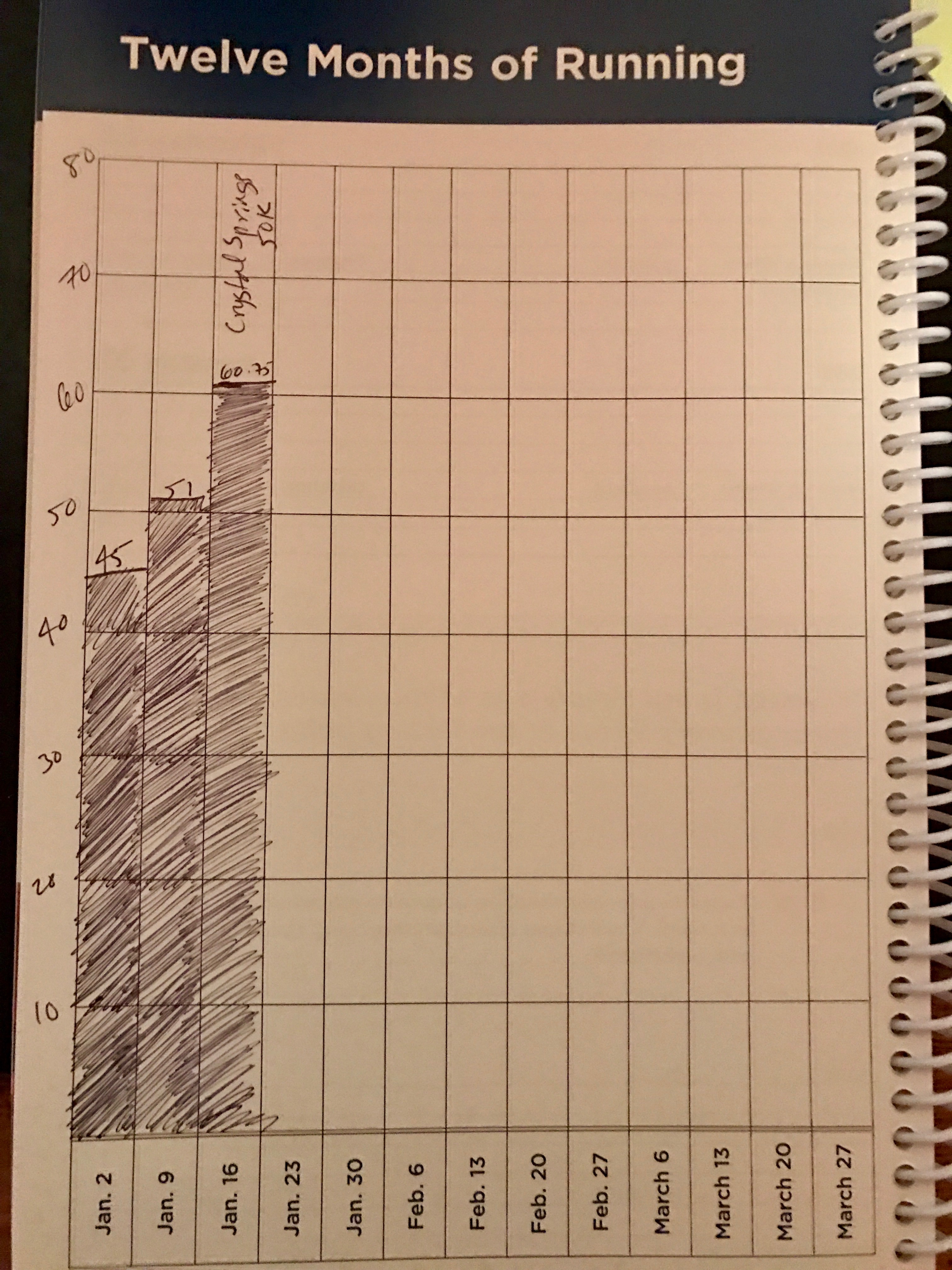
My running-total bar graph. As mentioned in a prior post, I use Training Peaks to log workouts and analyze data, but I also keep a backup handwritten log that doubles as a diary and includes this weekly chart.
Many thanks to Scott Dunlap (see his blog) for the use of his forest shots above. And here’s another race report from this event with great pics and descriptions, by Kowsik Guruswamy.



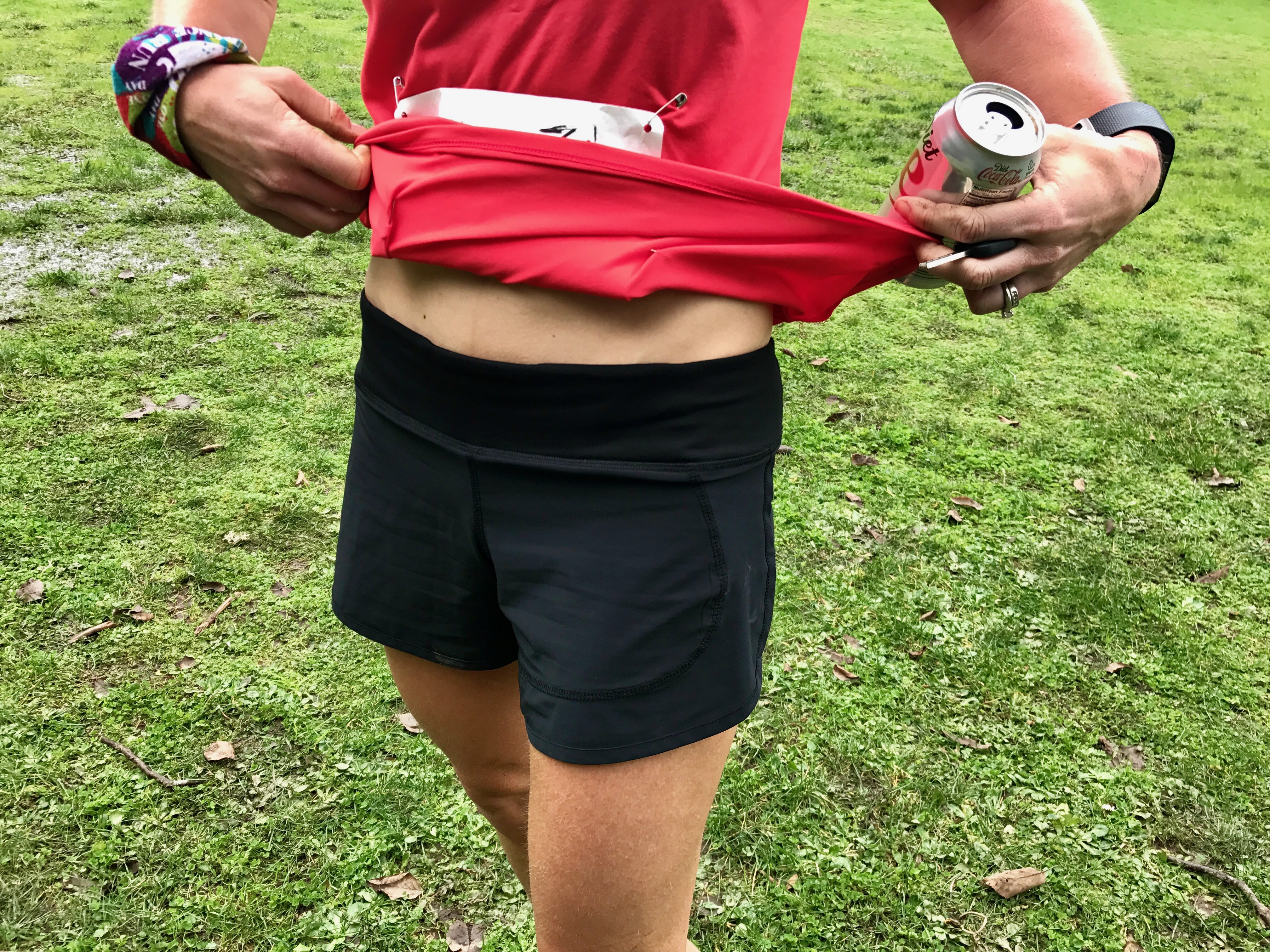
rabbit shorts!! They look awesome.
You write really well, Sarah! Over last few months, I have become a huge fan of your writing. Good luck for the upcoming races!